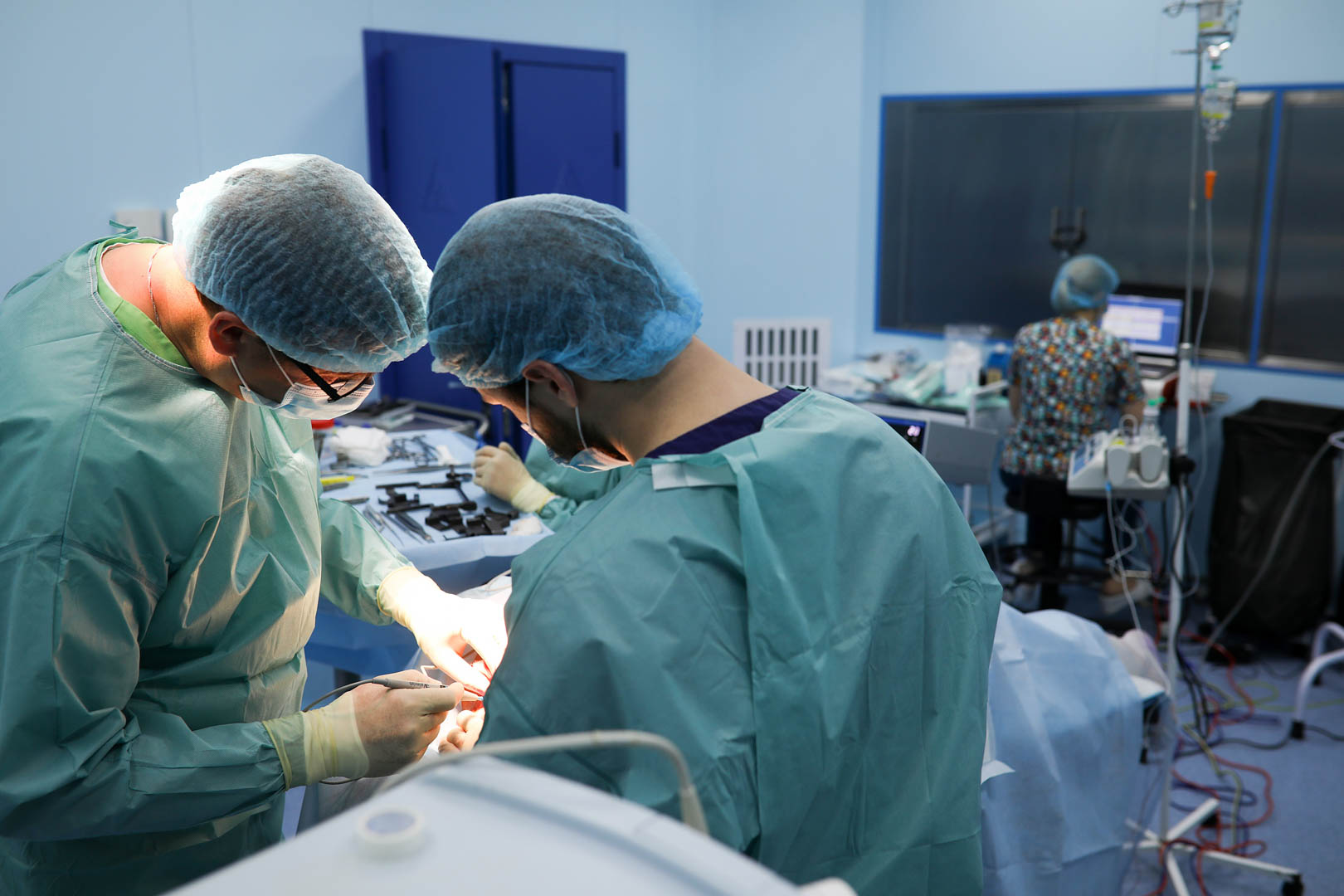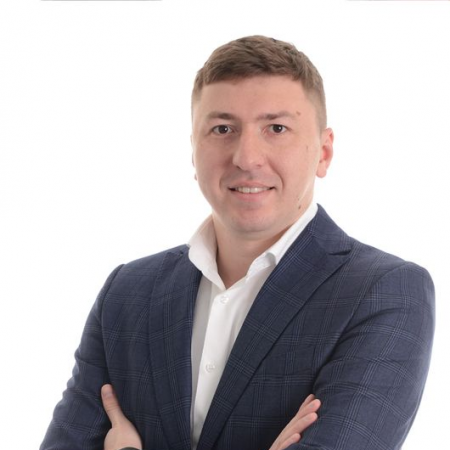Endovascular embolization of a cerebral aneurysm
What is cerebral vascular aneurysm embolization?
Endovascular embolization of a brain aneurysm - minimally invasive endovascular intervention, which is to exclude the aneurysm from the bloodstream of cerebral vessels using a special material (separating microspirals, stents or balloons); "Sealing" with a special adhesive composition (cyanoacrylate) or liquid plastic (polyvinyl alcohol), or overlapping microspirals of platinum.
Most often, specialists in Ukraine perform embolization of intracranial arterial aneurysms of microcoils, the essence of the method is to fill the aneurysm sac with platinum microcoils of a certain size and shape. As a result of the operation, blood does not enter the aneurysm, thus eliminating the risk of its increase and rupture.
What is a cerebral vascular aneurysm and how dangerous is it?
Aneurysm of cerebral vessels is a pathological, different in shape and length local protrusion of the vessel wall of the brain. The protrusion begins to compress the surrounding brain structures, disrupting the functions of the central nervous system.
The described pathology is dangerous for the patient due to the high risk of rupture of the aneurysm with hemorrhage into the brain tissue, in the form of hemorrhagic stroke or subarachnoid hemorrhage, which leads to severe disability or even death.
What is the current problem of cerebral aneurysms?
Vascular aneurysms of the brain are a "slow-acting bomb", as the risk of rupture of the vessel wall is extremely high.
Today, from 600 thousand to 2 million people in Ukraine have aneurysms, about 4-12 thousand aneurysms rupture annually. The biggest problem is that cerebral vascular aneurysms affect people of working age (most often between the ages of 30 and 50).
What is the revolutionary nature of endovascular interventions in cerebral aneurysms?
Over the past 15-20 years, the world of surgical medicine has undergone significant changes that have allowed for serious interventions in the body without traumatic incisions. One of the revolutionary achievements in the field of vascular surgery and neurosurgery is the technique of endovascular embolization, which allows you to fight various vascular defects and diseases virtually without surgery.
If there are signs of the disease, you should immediately seek specialized medical care.
Why do cerebral vascular aneurysms occur?
Vascular aneurysms of the brain can be congenital or acquired. In the first case, the disease occurs against the background of an existing abnormality in the development of one of the walls of the artery.
In addition to heredity, the development is influenced by the following factors:
- high blood pressure;
- atherosclerosis (vascular calcification);
- head injuries;
- age from 50 years and older;
- alcohol and drug abuse;
- diseases of the circulatory system;
- low estrogen levels after menopause;
- smoking (contributes to atherosclerosis, raises blood pressure).
What are the symptoms of a cerebral vascular aneurysm?
The danger of an aneurysm of the arterial wall lies in their "quiet" development. In the early stages, a person may not even realize that there is a serious problem, because small aneurysms do not compress the brain tissue and do not cause discomfort.
The clinical picture is manifested in the later stages of the disease. Pay attention to the first signs of problems that may be:
- visual disturbances, pain in the eyes and head;
- change in motor functions of the extremities - the patient may suddenly "forget" to hold a spoon or his handwriting deteriorates sharply;
- violation of tactile and pain sensitivity of the legs;
- seizures;
- numbness of the facial muscles, inability to smile, sudden violation of diction.
These signs indicate compression of brain tissue. A neurological deficit is developing, which should be the first signal and an urgent reason to seek help from the specialists of the Dobrobut Center in Kyiv.
If the disease progresses, the aneurysm may rupture. This condition is already life-threatening. Pay attention to the symptoms:
- intense headache, which is poorly amenable to medical correction;
- photophobia;
- nausea vomiting;
- double vision;
- loss of consciousness;
- intense convulsions.
If a person develops the above symptoms, an ambulance should be called immediately. If necessary, the patient will be taken to the specialists of the Medical Center "Dobrobut" for emergency highly specialized neurosurgical care.
How is a cerebral vascular aneurysm diagnosed?
To detect an aneurysm, a neurologist or neurosurgeon may prescribe the following instrumental examination methods:
- computed tomography (CT) - the procedure is often used to determine the rupture of a vessel with hemorrhage in the brain tissue;
- magnetic resonance imaging (MRI);
- angiography of cerebral vessels - the method allows you to assess the size, location, and structure of the aneurysm.
If a subarachnoid rupture of the aneurysm is suspected, the neurologist will also perform a lumbar puncture to assess the condition of the cerebrospinal fluid.
When is endovascular embolization indicated for cerebral vascular aneurysm?
Endovascular embolization for aneurysms is indicated in the following cases:
- age over 50 years;
- localization of aneurysms of complex localization (vertebrobasilar basin, aneurysms of the cavernous department of the internal carotid or ophthalmic segment of the internal carotid artery);
- if the size of the aneurysm is 7 mm or more;
- nonspherical (irregular) shape and the presence of diverticula;
- in the presence of a large aneurysm and a narrow neck;
- the size of the aneurysm exceeds the diameter of the vessel to which the aneurysm is attached;
- if there is an increase in the size of the aneurysm by 1 mm or more during the last 6 months;
- the appearance of new clinical manifestations (symptoms of cranial nerve damage, appearance and/or change like the headache, ischemic disorders in the pool of the artery carrying the aneurysm);
- "Perianeurysmal" environment - contact of the aneurysm with the dura mater, skull bones, cranial nerves, arteries, and veins;
- multiple aneurysms;
- if there is a history of hemorrhage from another aneurysm;
- if there are favorable factors such as smoking and hypertension.
What is the location of the brain aneurysm embolized by specialists of MM "Dobrobut" in Kyiv?
In our Medical Center endovascular operations are performed for the following cerebral vascular aneurysms:
- internal carotid artery aneurysm (ICA) (cervical, stony, cavernous, ophthalmic, paraclinoid, supraclinoid ICA);
- anterior cerebral artery aneurysm (ACA);
- anterior connective artery aneurysm (ACA);
- middle cerebral artery aneurysm (MCA);
- posterior cerebral artery aneurysm (PCA);
- aneurysm of the main artery (MA, basilar artery);
- vertebral artery aneurysm (VA);
- posterior inferior cerebellar artery aneurysm (PICA);
- anterior lower cerebellar artery aneurysm (ALCA);
- upper cerebellar artery aneurysm (UCA);
- posterior connecting artery aneurysm (PCA);
- pericallosal artery aneurysm;
- and other localizations, respectively.

What types of spiral embolization are performed at our Medical Center?
- Embolization of intracranial arterial aneurysm of microspirals with balloon assistance.
The balloon-assistance method is used to treat aneurysms of the brain with a wide neck. The principle of using this technique is based on the placement of a temporary balloon in the projection of the neck of the aneurysm. The balloon is inflated, and against the background of inflating the balloon is the installation of microcoils in the lumen of the aneurysm sac, which prevents the loss or untwisting (prolapse) of the turns of the microcoils in the lumen of the parent artery.
- Embolization of intracranial arterial aneurysm of microspirals with stent assistance.
Stent-assisting in embolization of microspiral aneurysms has a similar principle of protection of the neck of the aneurysm, as in balloon assistance. However, protection in the case of stent implantation is constant. The framework for potential endothelialization in a projection of a neck of an aneurysm is created.
Note that long-term antiplatelet therapy is required after stent implantation.
What are the advantages of endovascular embolization over open surgery?
Endovascular embolization of the aneurysm is a minimally invasive procedure, without incisions, with a minimal rehabilitation period. The operation is performed by inserting a special "wire" into the affected vessel - a small soft metal spiral, which blocks the blood supply to the formed bag.
Endovascular methods have a number of advantages. They are minimally invasive, associated with minimal risk, and often do not require general anesthesia. Recovery time is minimal, access to hard-to-reach areas is significantly expanded.
Modern technologies of endovascular neurosurgery, performed by specialists of the medical network of Dobrobut clinics in Kyiv, make it possible to perform these operations routinely.
What spirals are used for embolization?
The catheter is a long thin plastic tube that is much smaller than a "pencil lead" or about 1/8 inch in diameter.
Spirals are of three types:
- bare platinum spirals;
- coated platinum spirals;
- biologically active spirals.
Metal stents are used to hold helices inside the aneurysm.
Spirals are made of soft platinum wire smaller than a strand of hair and are available in different diameters and lengths.
All instruments and consumables (spirals, stents, clips and everything for their implantation) are used only disposable from the best European and American manufacturers.
How is the preparation for endovascular embolization in the clinics of MM "Dobrobut"?
Before carrying out this technique of treatment the patient passes necessary researches.
At the Dobrobut Medical Center in Kyiv, you can perform all the necessary tests, undergo CT, MRI, ultrasound, radiography.
Before choosing a method of treatment, the clinic will take the necessary blood tests and prepare the patient for endovascular interventions.
A complete list of procedures will be prescribed by a doctor after the initial examination and preliminary diagnosis. Preparation for surgery may also include a special diet.
To avoid complications, our neurosurgeons use the method of computer or 3D visualization. Both methods are equally effective in cases where it is necessary to go through all the stages of the intervention step by step.
One week before endovascular embolization, the patient stops taking anti-inflammatory and anticoagulant drugs.
The patient should tell the specialists about all the medications he is taking, including herbal supplements. List any allergies, especially to local anesthetics, general anesthetics, or contrast agents.
Tell your doctor about chronic or other illnesses.
Proper diagnosis helps our neurosurgeons choose the type of procedure for aneurysms and plan interventions.
How do you prepare for endovascular embolization?
The day before the operation
If the intervention is planned for the morning, the patient can afford a light dinner the day before.
All prescribed medications should be taken to the hospital. Until the doctor allows, the patient should stop taking the medication. If taking these drugs is vital - report it to the neurosurgeon who operates. This is necessary for the correction of this type of therapy. The doctor will tell you when you can resume taking drugs that affect blood clotting.
It is recommended to abstain from alcohol before the operation.
It is strongly recommended to quit smoking to avoid life-threatening health factors.
Take a shower before surgery.
What to do on the day of surgery?
The patient should not eat or drink anything, including chewing gum, lollipops, water, coffee, even if the procedure is performed under local anesthesia.
Contact lenses, dentures, hearing aids, and more should be removed before the operation in the ward.
How is an endovascular intervention performed?
Endovascular intervention is performed under local anesthesia. The duration of the operation can be short (several tens of minutes), but can also take up to several hours. The duration of the operation depends on the characteristics of the aneurysm, its location relative to vital areas of the brain, the general condition of the patient. After the operation, the patient returns to a normal lifestyle in a few hours without negative consequences for his body.
The neurosurgeon first punctures the anterior femoral surface near the inguinal ligament to access the femoral artery, and an introducer is inserted into the artery, a small elastic tube with a valve through which all other instruments are passed without injuring the artery wall. The brain aneurysm is approached with the help of very thin tubes, called microcatheters, and then, they are pushed through the blood vessels to the aneurysm inside the skull. All this time, the location of the catheter is monitored using a special X-ray machine. Sometimes at closing (embolization) of aneurysms, it is necessary to use special stents (a kind of a fine-mesh tube with cells) which interfere with an exit of spirals from a gleam of an aneurysm. Then, through the cells in the stent, the following spirals are inserted into the aneurysm.
The coils used in this procedure are made of soft platinum metal and have the shape of a spring. These spirals are very small and thin, varying in size from about twice the width of a human hair (largest) to less than one hair (smallest).
The aneurysm filled with a wire spiral is excluded from a blood groove and gradually overgrown with a connecting fabric, that is, the possibility of its rupture is excluded. At the final stage, the instruments are sequentially removed from the vascular bed, the puncture site of the femoral artery is sutured with a special device. The day after the intervention, the patient is observed in intensive care.
How is the postoperative period?
After surgery, the patient can expect to return home after spending one night in the intensive care unit and can expect to return to normal activities within 2 days. The doctor will provide detailed information on postoperative care before discharge from the hospital.
What are the advantages of endovascular embolization compared to the risks of intervention?
Advantages:
- the use of coils and stents to close the aneurysm is effective for prolonging life and relieving symptoms;
- embolization is the effective treatment of cerebral aneurysms that were previously considered inoperable. This procedure is less invasive and requires significantly less recovery time than open surgery;
- no surgical incision is required - only a small incision in the skin that does not require suturing.
Risks:
- any procedure in which a catheter is placed in a blood vessel is associated with certain risks. These risks include damage to the blood vessel, bruising or bleeding at the puncture site, and infection. Your doctor will take precautions to reduce these risks;
- there is a slight risk of death or illness. Embolization of non-ruptured aneurysms carries less risk than treatment performed in emergencies;
- approximately 7% of cases require additional treatment or surgery after embolization.
Why the medical network of Dobrobut clinics in Kyiv?
- Thanks to best and modern equipment and highly qualified specialists of the Medical Center can detect pathology in the early stages of development and promptly perform interventions that contribute to the successful treatment of brain aneurysms.
- Neurosurgeons working at Dobrobut Medical Center are the best specialists not only in Ukraine but also in Europe, which guarantees a successful outcome of the operation.
- Comprehensive assessment of the disease and prognosis of treatment of cerebral aneurysms.
- High level of service and balanced pricing policy in Kyiv. Loyal prices for the highest quality services.
- Our patients are always in the center of our attention, so everyone gets an individual approach and a personal coordinator who will be constantly in touch with the patient.
- All operations in MM "Dobrobut" are performed according to the protocols and in accordance with the standards of European clinics (without restrictions on the quality and quantity of consumables).
Therefore, in the fight against aneurysms, victory is always on our side.
How to get advice from our specialists "Dobrobut"?
If you have similar symptoms, we advise you to make an appointment with our specialists. Timely consultation will prevent negative consequences for your health.
You can find out details about the disease, treatment prices and make an appointment with a specialist at the Dobrobut Medical Center both on our website and by calling the call center.


